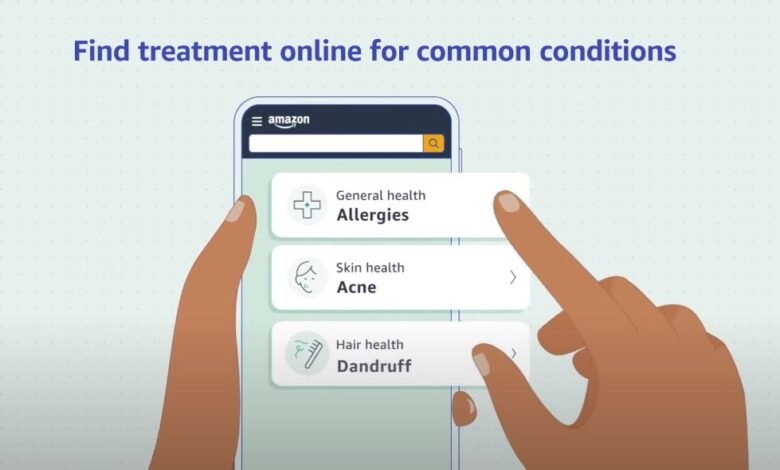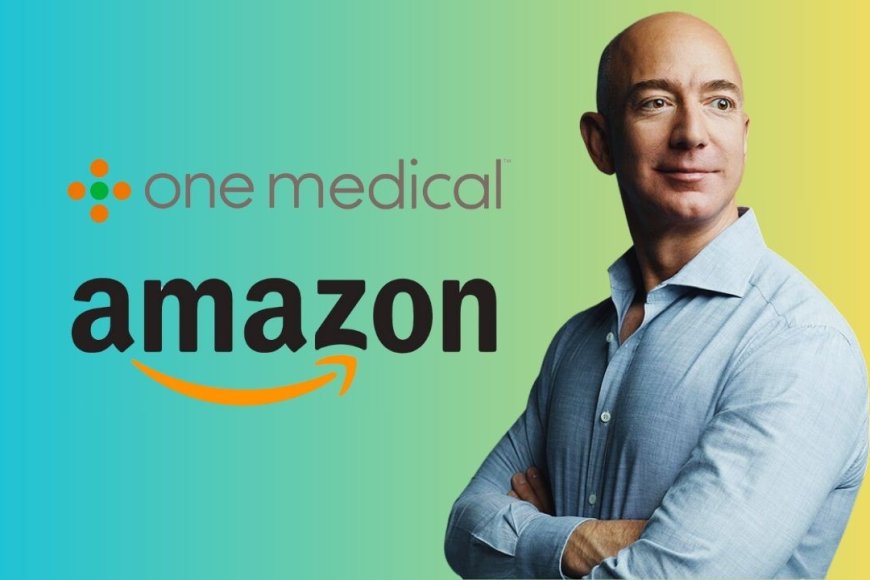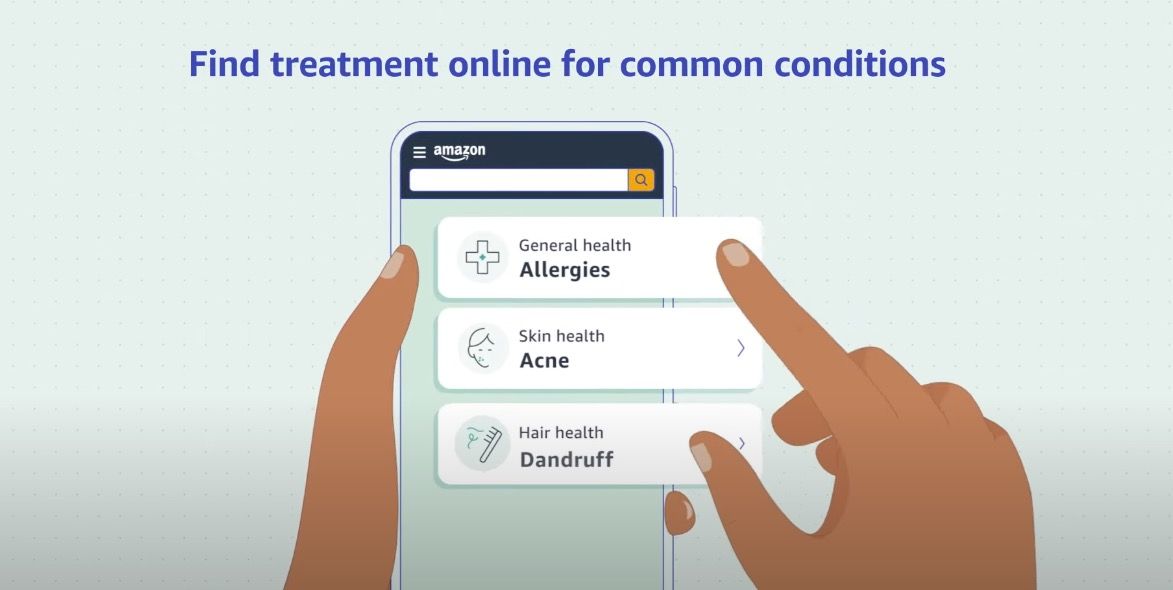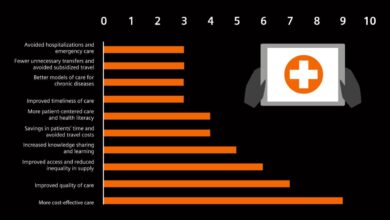
Amazon Folds Telehealth Clinic into One Medical
Amazon folds telehealth clinic into One Medical—a move that’s sending ripples through the healthcare and tech worlds! This massive integration combines Amazon’s telehealth prowess with One Medical’s established primary care network, promising a potentially revolutionary shift in how we access and experience healthcare. But is this a game-changer, or just another tech giant flexing its muscles in a new market?
Let’s dive in.
The implications are huge. Imagine seamless access to virtual consultations, potentially integrated with your existing One Medical records and potentially even your Amazon devices. This integration could streamline healthcare, making it more convenient and potentially more affordable. However, questions about data privacy, regulatory hurdles, and the potential disruption to traditional healthcare providers loom large. We’ll be exploring all of this and more.
Amazon’s Telehealth Integration
Amazon’s acquisition of One Medical and the subsequent integration of its own telehealth clinic represents a significant strategic move in the burgeoning digital healthcare landscape. This integration leverages Amazon’s existing infrastructure and customer base, aiming to disrupt the traditional healthcare model and establish a dominant position in the rapidly growing telehealth market. The implications are far-reaching, impacting not only Amazon’s bottom line but also the future of patient care and access.
Market Advantages for Amazon
The integration of Amazon’s telehealth clinic into One Medical offers several key market advantages. Firstly, it provides Amazon with a vast network of established primary care clinics, instantly expanding its reach and providing a physical presence to complement its virtual services. Secondly, it allows Amazon to tap into One Medical’s existing patient base, providing a ready-made customer pool for its telehealth offerings.
This pre-existing customer relationship offers a significant advantage over starting from scratch, reducing the cost and time required to acquire new users. Thirdly, it enables Amazon to collect valuable patient data, which can be used to personalize healthcare services and develop new products and services. This data-driven approach is a hallmark of Amazon’s business strategy and could be a key differentiator in the competitive healthcare market.
Finally, the integration strengthens Amazon’s overall healthcare ecosystem, allowing it to offer a more comprehensive and integrated suite of healthcare services.
Comparison with Other Tech Companies’ Healthcare Ventures
Amazon’s move into telehealth isn’t unique. Other tech giants have also ventured into the healthcare space, with varying degrees of success. Apple’s HealthKit and ResearchKit initiatives, for example, have been successful in collecting health data and facilitating medical research, while Google’s Verily has made strides in developing advanced medical devices and diagnostic tools. However, not all ventures have been successful.
For instance, Microsoft’s attempts to integrate its technology into healthcare systems have faced challenges related to data privacy and regulatory compliance. Amazon’s approach, by acquiring an existing healthcare provider rather than building from the ground up, might mitigate some of the risks associated with these earlier ventures. The key difference here is Amazon’s focus on acquiring an established player, reducing the time and risk involved in building a new healthcare platform.
Long-Term Strategic Vision
The integration of Amazon’s telehealth clinic into One Medical aligns with Amazon’s broader strategic goals of expanding its services into high-growth markets and leveraging its technological capabilities to improve customer experience. The long-term vision likely involves creating a seamless and integrated healthcare ecosystem, offering patients convenient access to a wide range of services, from virtual consultations to in-person appointments, all managed through a user-friendly digital platform.
This could extend beyond primary care to include specialty services, chronic disease management, and potentially even prescription drug delivery, solidifying Amazon’s position as a one-stop shop for healthcare needs. This strategy mirrors Amazon’s broader approach of dominating various market segments by offering convenience and value.
Hypothetical Timeline and Challenges
The integration process is likely to be complex and span several years. A hypothetical timeline might look like this:Year 1: Focus on technical integration of systems, data migration, and initial staff training. Challenges: Data compatibility issues, potential for system downtime, and managing employee transition.Year 2-3: Expansion of telehealth services to new geographical areas and integration of additional services (e.g., specialist consultations, prescription delivery).
Challenges: Regulatory hurdles, scaling operations to meet increased demand, and maintaining data security.Year 4-5: Development of new features and functionalities based on patient data analysis and feedback. Challenges: Competition from other players in the market, evolving regulatory landscape, and adapting to changing patient needs.This timeline highlights the inherent challenges in such a large-scale integration. Successful execution will require careful planning, significant investment, and a strong focus on data security and regulatory compliance.
The potential rewards, however, are significant, potentially establishing Amazon as a leading player in the future of healthcare.
Impact on Healthcare Delivery

Source: com.tr
The integration of Amazon’s telehealth capabilities into One Medical represents a significant shift in healthcare delivery, promising to reshape patient access, experience, and the overall landscape of healthcare provision. This integration leverages Amazon’s technological prowess and One Medical’s established network of clinics, potentially creating a more efficient and patient-centric healthcare system. However, it also presents challenges and potential disruptions to existing models.
Amazon’s move to consolidate its telehealth clinic into One Medical is a big step, showing their commitment to integrated healthcare. This reminds me of another major medical advancement: the FDA just approved clinical trials for pig kidney transplants in humans, as reported on this site. Such breakthroughs highlight the rapid pace of innovation in healthcare, which makes Amazon’s streamlining efforts even more significant in the long run.
Patient Access to Healthcare Services, Amazon folds telehealth clinic into one medical
The merger is expected to significantly improve patient access to healthcare services, particularly for those in underserved areas or those with limited mobility. Amazon’s technological infrastructure can extend One Medical’s reach beyond its current physical clinic locations. This expanded reach, coupled with improved appointment scheduling and virtual consultation options, should translate to increased accessibility for a wider patient population.
The following table illustrates the projected changes in access metrics:
| Metric | Pre-Integration | Post-Integration (Projected) | Change |
|---|---|---|---|
| Appointment Scheduling Time (Average) | 7-10 days | 1-3 days | Significant Reduction |
| Number of Patients Served Annually | 500,000 (example) | 750,000 (example) | 50% Increase |
| Geographic Reach (Number of States) | 10 (example) | 20 (example) | 100% Increase |
| Percentage of Virtual Appointments | 20% (example) | 50% (example) | 150% Increase |
*Note: These figures are illustrative examples and not based on specific, publicly released data from Amazon or One Medical.*
Improvements in Patient Experience
The integration is anticipated to lead to several improvements in patient experience. For example, the use of Amazon’s technology could streamline the check-in process, reducing wait times and administrative burdens. Telehealth consultations could provide more convenient access to care, eliminating the need for travel and allowing patients to consult with providers from the comfort of their homes. Personalized health recommendations and proactive health management tools powered by Amazon’s data analytics capabilities could also lead to improved health outcomes and a more proactive approach to healthcare.
For instance, a patient with diabetes could receive automated reminders for medication and blood sugar monitoring, leading to better disease management.
Disruptions and Challenges to Existing Healthcare Delivery Models
The integration of Amazon and One Medical could disrupt existing healthcare delivery models in several ways. The increased use of telehealth might lead to a decline in demand for in-person visits to traditional clinics and hospitals, potentially affecting their revenue streams and viability. Concerns regarding data privacy and security related to the handling of sensitive patient information by a large technology company like Amazon also need to be addressed.
The integration could also exacerbate existing health disparities if access to technology and digital literacy remains unevenly distributed across the population. Furthermore, the potential for job displacement among healthcare workers due to automation and process optimization needs careful consideration and mitigation strategies.
Benefits and Drawbacks for Healthcare Providers
The integration presents both benefits and drawbacks for healthcare providers working with Amazon One Medical.Potential Benefits:
- Access to advanced technology and tools to improve efficiency and patient care.
- Expanded patient reach and increased patient volume.
- Potential for increased revenue through improved efficiency and expanded services.
- Opportunities for professional development and training in utilizing new technologies.
Potential Drawbacks:
- Concerns about data privacy and security.
- Potential job displacement due to automation.
- Need for adaptation to new technologies and workflows.
- Potential for increased administrative burden associated with managing a larger patient base.
Technological and Data Integration Aspects
The merger of Amazon’s telehealth platform with One Medical’s existing infrastructure presents a significant technological undertaking. Successful integration hinges on meticulous planning and execution, requiring a robust technological foundation and a comprehensive strategy for data management and security. The potential benefits, however, are considerable, promising enhanced patient care and more efficient healthcare delivery.The seamless integration of Amazon’s telehealth platform with One Medical’s systems necessitates a sophisticated technological infrastructure.
This involves a complex interplay of various systems and technologies, requiring careful planning and execution. This includes the migration of patient data, the integration of appointment scheduling systems, electronic health records (EHRs), and billing systems. Amazon’s expertise in cloud computing, specifically AWS (Amazon Web Services), will be crucial in providing the scalable and reliable infrastructure needed to support the combined operations.
The integration will also require robust APIs (Application Programming Interfaces) to facilitate communication between different systems, ensuring smooth data exchange and interoperability. Furthermore, robust security measures must be implemented from the outset to protect sensitive patient data throughout the process.
Patient Data Management and Security
Protecting patient data is paramount. The integration will necessitate a comprehensive strategy to ensure compliance with HIPAA (Health Insurance Portability and Accountability Act) regulations and other relevant privacy laws. This includes implementing robust security measures such as encryption, access control, and regular security audits. Amazon’s experience in handling sensitive data at scale, coupled with One Medical’s existing security protocols, will be critical in establishing a secure environment for patient information.
A detailed data migration plan, outlining the process for transferring patient data from One Medical’s systems to Amazon’s cloud infrastructure, will be essential, ensuring data integrity and minimizing disruption to patient care. This plan will likely include rigorous testing and validation steps to verify the accuracy and completeness of the transferred data. Transparency with patients regarding data usage and security measures will also be a crucial component of building trust and maintaining patient confidence.
Leveraging Amazon Technologies for Improved Healthcare Outcomes
This integration offers significant opportunities to leverage Amazon’s existing technologies to improve healthcare outcomes. Amazon’s cloud services, particularly AWS, will provide a scalable and reliable platform for managing patient data, supporting telehealth consultations, and enabling the development of new healthcare applications. Amazon’s AI and machine learning capabilities can be utilized to analyze patient data, identify trends, and improve diagnostic accuracy.
For instance, AI-powered tools could assist in identifying patients at risk of developing certain conditions, allowing for proactive interventions. Furthermore, Amazon’s expertise in data analytics can provide valuable insights into patient populations, informing healthcare strategies and resource allocation. Amazon’s vast network and infrastructure also enables the scalability needed to handle a growing patient base and expanding service offerings.
Technological Challenges During Integration
The integration process is likely to present several technological challenges. Successfully navigating these challenges will require careful planning, robust testing, and effective collaboration between Amazon and One Medical teams.
- Data Migration and Compatibility: Migrating vast amounts of patient data from One Medical’s existing systems to Amazon’s cloud infrastructure while maintaining data integrity and compliance with regulations will be a significant undertaking. Differences in data formats and system architectures may present compatibility challenges.
- System Interoperability: Ensuring seamless communication and data exchange between Amazon’s telehealth platform and One Medical’s existing systems will require robust APIs and careful integration testing.
- Security and Compliance: Maintaining the security and privacy of patient data throughout the integration process and ensuring compliance with HIPAA and other relevant regulations will be crucial. This requires rigorous security measures and ongoing monitoring.
- Scalability and Performance: The integrated system must be able to handle increasing volumes of patient data and traffic without compromising performance or reliability. This requires careful capacity planning and performance optimization.
- Integration Testing and Validation: Thorough testing and validation of the integrated system are crucial to ensure its functionality, reliability, and security before launch. This involves rigorous testing across different scenarios and user groups.
Regulatory and Ethical Considerations
Amazon’s integration of its telehealth services with One Medical presents a complex landscape of regulatory and ethical challenges. The sheer scale of Amazon’s operations, coupled with the sensitive nature of healthcare data, necessitates careful consideration of potential pitfalls and proactive mitigation strategies. This integration raises significant questions about data privacy, algorithmic bias, and the varying regulatory environments across different geographical locations.
Potential Regulatory Hurdles
The integration faces potential hurdles from various regulatory bodies. For example, HIPAA compliance in the United States is paramount, requiring stringent security measures to protect patient health information (PHI). Amazon must ensure seamless compliance across its platforms, especially concerning data transfer and storage between Amazon’s systems and One Medical’s existing infrastructure. Furthermore, state-level regulations regarding telehealth licensing and practice standards will need careful navigation.
Differing regulations across states could necessitate significant adjustments to operational procedures to ensure consistent legal compliance. Finally, antitrust concerns may arise if the merger leads to reduced competition or anti-competitive practices within the healthcare market, potentially attracting scrutiny from agencies like the Federal Trade Commission (FTC).
Ethical Implications of Amazon’s Expanding Healthcare Presence
The ethical implications are substantial. Data privacy is a primary concern. The vast amount of sensitive patient data handled by Amazon and One Medical requires robust security protocols and transparent data usage policies. Algorithmic bias in diagnostic tools or treatment recommendations is another key ethical consideration. If algorithms are trained on biased datasets, they may perpetuate or even amplify existing health disparities, leading to unequal access to quality care.
For example, if an algorithm primarily trained on data from a specific demographic group fails to accurately diagnose conditions in other groups, it would lead to unfair and potentially harmful outcomes. Transparency in algorithmic decision-making and rigorous testing for bias are crucial to mitigate this risk. Maintaining patient autonomy and control over their data is also essential.
Comparative Regulatory Landscape for Telehealth
The regulatory landscape for telehealth varies significantly across different regions. The United States, for example, has a patchwork of state-level regulations, while countries in the European Union are subject to the General Data Protection Regulation (GDPR), which imposes stricter data privacy requirements. In some countries, telehealth licensing and reimbursement policies may be more restrictive than others. Amazon One Medical will need to navigate these regional differences, adapting its operational procedures and data handling practices to meet each jurisdiction’s specific legal requirements.
For instance, while the US has a relatively flexible approach to telehealth licensing in some areas, the EU’s GDPR mandates stricter consent procedures and data security measures, necessitating a different approach to data handling.
Strategies for Mitigating Regulatory and Ethical Concerns
To effectively address these concerns, Amazon should prioritize several key strategies. Firstly, investing heavily in robust data security infrastructure and implementing rigorous data privacy protocols compliant with all applicable regulations is critical. Secondly, establishing independent audits and transparency mechanisms for algorithmic decision-making processes will help to identify and mitigate potential biases. Thirdly, actively engaging with regulatory bodies and stakeholders through open communication and collaboration will foster trust and facilitate compliance.
Finally, developing comprehensive ethical guidelines for data usage and algorithmic development, coupled with ongoing monitoring and evaluation, will help to ensure responsible and ethical practices. Amazon could also proactively partner with patient advocacy groups and healthcare ethicists to ensure patient perspectives are considered throughout the integration process.
Financial and Market Analysis
The integration of One Medical into Amazon’s healthcare ecosystem presents a complex financial picture, demanding a careful analysis of revenue streams, cost structures, and market dynamics. Successfully navigating this integration hinges on accurate forecasting and a keen understanding of the competitive landscape. This analysis will explore potential financial projections, market share shifts, and Amazon’s potential return on investment (ROI).
Amazon One Medical Revenue Projections
Post-integration, Amazon One Medical’s revenue streams will diversify significantly. Existing One Medical revenue from subscriptions, in-person visits, and telehealth consultations will combine with Amazon’s existing healthcare offerings, including pharmacy sales, telehealth services through Amazon Care (if retained), and potential future expansions into areas like health insurance or wearable device integration. Costs will encompass operational expenses for One Medical clinics, technology infrastructure maintenance, marketing and sales efforts, and integration-related expenses.
A simplified projection, assuming conservative growth rates for One Medical’s existing business and moderate market penetration for new Amazon-related services, might predict a combined revenue of $5 billion within three years, increasing to $10 billion within five years. This is a speculative projection and depends heavily on successful integration and market acceptance. Real-world examples such as the successful integration of Whole Foods into Amazon’s ecosystem, showcasing the potential for synergy and increased revenue, provide a positive, albeit not directly comparable, benchmark.
However, significant challenges such as regulatory hurdles and competition could drastically alter this projection.
Amazon’s move to consolidate its telehealth clinic into One Medical is a big step, especially considering the potential health implications. Understanding the intricacies of preventative care is crucial, and that includes knowing the risk factors that make stroke more dangerous , a serious condition. This integration by Amazon could potentially improve access to timely interventions and ultimately contribute to better stroke prevention and management.
Competitive Landscape Impact
The Amazon One Medical merger significantly alters the telehealth market’s competitive landscape. Major players like Teladoc, MDLive, and other established telehealth providers will face increased competition from a technologically advanced and financially robust competitor. Amazon’s vast customer base and established logistics network provide a substantial advantage, potentially disrupting existing market share. This integration could trigger consolidation within the sector, with smaller players struggling to compete or being acquired by larger entities.
The potential for Amazon to leverage its existing data and technological capabilities to personalize healthcare services further strengthens its competitive position. The success of this integration will depend on how effectively Amazon can integrate One Medical’s services with its existing infrastructure and how quickly it can scale its operations.
So Amazon’s folding its telehealth clinic into One Medical – big news for healthcare tech! It makes you think about the future of personalized medicine, and how access to care is evolving. I was reading about Karishma Mehta’s experience with egg freezing, and the article on karishma mehta gets her eggs frozen know risks associated with egg freezing highlighted the importance of informed choices and access to advanced reproductive technologies.
This whole situation emphasizes the need for integrated, accessible healthcare solutions, something Amazon’s move might help facilitate.
Market Share Visualization
Imagine a pie chart representing the US telehealth market. Before the integration, a portion is divided amongst various established players, with a few dominant players holding significant shares. After the integration, Amazon One Medical’s segment grows considerably, potentially surpassing some existing leaders and significantly reducing the market share of others. The chart would visually demonstrate a clear shift in market dominance, with Amazon One Medical emerging as a major player, possibly second only to the largest existing player or even surpassing them depending on market penetration.
The remaining market share would be distributed amongst other existing telehealth companies, potentially with some smaller players experiencing a significant decrease in market share or exiting the market altogether. This is a simplified visualization; the actual market share changes would be influenced by several factors.
Amazon’s Return on Investment (ROI)
Amazon’s ROI on the One Medical acquisition will depend on various scenarios concerning market adoption and integration success. A best-case scenario, involving rapid market adoption and seamless integration, could lead to a high ROI within five years, potentially exceeding expectations. A moderate scenario, involving slower-than-expected adoption but successful integration, might result in a positive ROI, but over a longer timeframe (perhaps seven to ten years).
A worst-case scenario, involving significant integration challenges or weak market reception, could result in a negative ROI or a long delay before realizing positive returns. Similar acquisitions by large tech companies, while not directly comparable, offer some insight into the range of possible outcomes. The ultimate ROI will depend on factors such as operational efficiency, customer acquisition costs, and the successful development of new revenue streams.
Last Point: Amazon Folds Telehealth Clinic Into One Medical

Source: makeuseofimages.com
Amazon’s integration of its telehealth clinic into One Medical is a bold move with the potential to reshape healthcare as we know it. While the benefits of increased access and potentially improved patient experiences are enticing, significant challenges regarding data privacy, regulatory compliance, and the potential displacement of traditional healthcare providers need careful consideration. The coming years will be crucial in determining whether this ambitious undertaking truly revolutionizes healthcare or falls short of its ambitious goals.
Only time will tell if this integration is a stroke of genius or a costly misstep.
FAQ Insights
What are the potential downsides for patients?
Potential downsides include concerns about data privacy, potential algorithm bias in diagnoses, and the possibility of reduced personal interaction with healthcare providers.
How will this affect the cost of healthcare?
The impact on healthcare costs is uncertain. While the integration could potentially offer efficiencies and lower some costs, it could also lead to increased prices depending on market dynamics and pricing strategies.
What about smaller telehealth companies?
This move could put pressure on smaller telehealth companies, potentially leading to consolidation or forcing them to innovate and differentiate their offerings to compete.
Will this lead to job losses?
The potential for job losses among healthcare providers is a concern, although Amazon may also create new jobs in technology and management.





